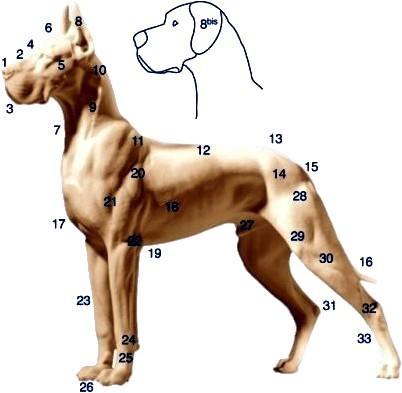33. Rear Pastern
Head
Cranial region
Skull : In harmony with the general appearance. Long, narrow, distinct, full of expression. Finely chiselled, specially under the eyes. Superciliary ridges well developed but not protruding. The distance from tip of nose to stop and from stop to the lightly defined occipital bone should be as equal as possible. The upper lines of muzzle and skull should run parallel. The head must appear narrow seen from the front with bridge of nose as broad as possible. Cheek muscles only slightly defined and in no way protruding.
Stop : Clearly defined.
Facial region
Nose : Well developeded, rather broad than round with large nostrils. Must be black with the exception of harlequins (white with black patches). In these a black nose is desired but a butterfly nose (black with pink patches) or flesh coloured nose is tolerated. In blue dogs the colour of the nose is anthracite (diluted black).
Muzzle : Deep and as rectangular as possible. Well defined corners of lips. Dark pigmented lips. In harlequins not totally pigmented or flesh coloured lips are tolerated.
Jaws/Teeth : Well developed broad jaws. Strong sound and complete scissor bite (42 teeth according to the dentition formula).
Eyes : Of medium size with lively friendly intelligent expression. As dark as possible, almond shaped with close fitting lids. In blue dogs slightly lighter eyes are tolerated. In harlequins light eyes or two differently coloured eyes are to be tolerated.
Ears : Naturally pendant, set on high, of medium size, front edges lying close to cheeks.
Neck
Long, clean, muscular. Well formed set on, tapering slightly towards the head, with arched neckline. Carried upright but inclined slightly forward.
Body
Withers : The highest point of the strong body. It is formed by the points of the shoulder blades which extend beyond the spinal processes.
Back : Short and firm, in almost straight line falling away imperceptibly to the rear.
Loins : Slightly arched, broad, strongly muscled.
Croup : Broad, well muscled. Sloping slightly from hipbone to tail set, imperceptibly merging into the tailset.
Chest : Reaching to the elbows. Well sprung ribs, reaching far back. Chest of good width with marked forechest.
Underline and belly : Belly well tucked up towards rear, forming a nicely curved line with the underside of the brisket.
Tail
Reaching to the hocks. Set on high and broad, tapering evenly towards tip. In repose hanging down with natural curve. When dog is alert or moving, carried slightly sabre-like but not markedly above the backline. Bristle hair on tail undesirable.
Limbs
Forequarters
Shoulders : Strongly muscled. The long, slanting shoulder blade forms an angle of 100 to 110 degrees with the upper arm.
Upper arm : Strong and muscular, close fitting, should be slightly longer than the shoulder blade.
Elbows : Turned neither in nor out.
Forearm : Strong, muscular. Seen from front and side, completely straight.
Carpus : Strong, firm, only slightly standing out from the structure of the forearm.
Pastern : Strong, straight when seen from the front, seen from the side, barely slanting forwards.
Front feet : Rounded, well arched, well-knit toes (cat feet). Nails short, strong and as dark as possible.
Hindquarters
The whole skeleton is covered by strong muscles which make the croup, hips and upper thighs appear broad and rounded. The strong well angulated hind legs, seen from behind, are set parallel to the front legs.
Upper thigh : Long, broad, very muscular.
Stifles : Strong, positioned almost vertically under the hip joint.
Lower thigh : Long, of approximately the same length as the upper thigh. Well muscled.
Hocks : Strong, firm, turning neither in nor out.
Metatarsus : Short, strong, standing almost vertical to the ground.
Hind feet : Rounded, well arched, well-knit (cat feet). Nails short, strong and as dark as possible.
Gait/Movement
Harmonious, lithe, ground covering, slightly springy. Legs must be parallel in movement coming and going.
Skin
Tight fitting. In solid colours, well pigmented. In harlequins, the distribution of pigment mainly corresponds to the markings.
Coat
Hair
Very short, dense, smooth and close lying, glossy.
Colour
The Great Dane is bred in three separate colour varieties: Fawn and brindle, harlequin and black, and blue.
- Fawn : Light gold fawn to deep gold fawn. Black mask desired. Small white marks on chest and toes undesirable.
- Brindle : Basic colours, light to deep gold fawn with black stripes as regular and clearly defined as possible, running with the direction of the ribs. Black mask desired. Small white markings on chest and toes are undesirable.
- Harlequin (white with black splashed patches) : Basic colour pure white, preferably with no ticking. Pure black patches well distributed all over the body, having the appearance of being torn. Grey or brownish patches undesirable.
- Black : Jet black, white markings permitted. Included here are « Manteltiger » in which the black covers the body like a coat ("mantel") or blanket and muzzle, throat, chest, belly, legs and tip of tail may be white. Also dogs with basic white colour and large black patches so called "Plattenhunde".
- Blue : Pure steel blue, white markings on chest and feet permitted.
Height
Height at withers : Dogs at least 80 cm, bitches at least 72 cm.
| 

No comments:
Post a Comment